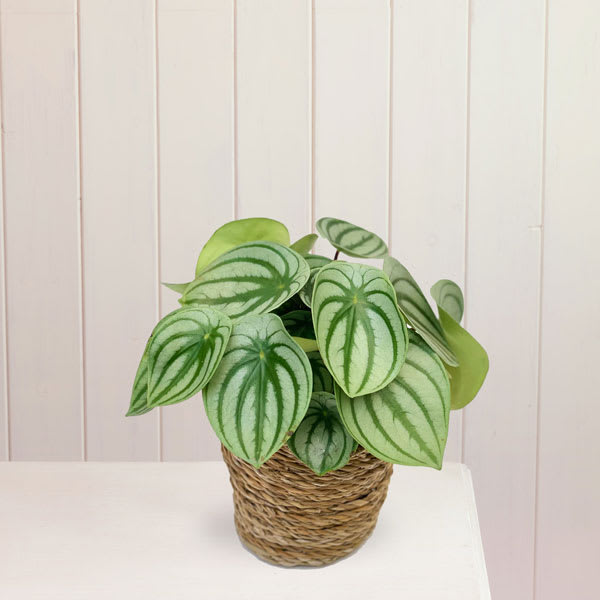Watermelon Peperomia: Plant Care Guide
A charming plant that loves to make a statement – provided that you place your Watermelon Peperomia in bright (but not direct) light, and damp (but not saturated) soil, it will provide you with a gorgeous display of watermelon striped leaves.
The Watermelon Peperomia is native to the northern parts of South America, including Brazil, Bolivia, and Venezuela. When cared for correctly, these plants can reach a height of 20 cm and are easy to grow at home.
Watermelon Peperomia Plant Leaves: The most intriguing characteristic of the Watermelon Peperomia is its leaves, as their oval-shaped, green-pointed tips and cream or silver stripes are said to resemble mini watermelons. These exquisite leaves grow on stems that boast a reddish-maroon hue and, just like certain succulents, a waxy feel.
Watermelon Peperomia Flowers: As well as their unique leaves, Watermelon Peperomia yield green-tinged flower spikes, which sit upon slim stalks. These minuscule flowers grow between 5cm and 10cm in length, although when grown indoors, they sometimes never come to fruition. This isn't a cause for concern and is solely down to their new environment. Thankfully the foliage is as pretty as the flowers.
Care needs
Fertilizing Watermelon Peperomia: Watermelon Peperomia tend to be slow growers and have moderate fertilizing requirements. To promote healthy growth, give your plant a little organic houseplant fertilizer every month during the growing season.
For best results, dilute the mixture to around one-half of the manufacturer's recommended dose. In some cases, Watermelon peperomia thrives without the need for additional feeding.
Pruning Watermelon Peperomia: It is important to give your plant a light pruning every spring. This is especially the case if you reside in a smaller space as the stems can become quite leggy. Trimming straggly growth and dead leaves will also promote growth and heighten the plant's appearance.
Diseases that can impact a Watermelon Peperomia's growth: Looking after your plant is the best way to prevent diseases and infections. The biggest culprit for the disease is overwatering, as soggy soil allows fungal diseases to take flight and causes root rot.
How to plant
To enable your plant to thrive, plant Watermelon Peperomias in well-draining, loamy potting soil. When the soil is partially dry, add water, and to increase humidity levels, mist the leaves every now and again.
To heighten growth, fertilize on a monthly basis during the growing season. The best potting mix necessitates the correct mix of organic and inorganic matter.
Watering needs
When it comes to growing Watermelon Peperomia plants, a top tip involves never allowing the roots to sit in waterlogged soil.
Oversaturated, soggy soil has a tendency to cause root rot and can lead to the death of your plant. It is important to remember these plants can withstand drought, which means their succulent-style, fleshy leaves are able to store moisture.
Light requirements
Often referred to as radiator plants, these shrubs love the heat. This means choosing a location that boasts warm air or even humid conditions. Peperomia Argyreia plants thrive in temperatures spanning from 18°C (65°F) to 26°C (80°F).
The most celebrated indoor spot for Watermelon peperomias is in the west or east-facing room. This means the plant will be able to enjoy lots of light without becoming a victim of the intense midday sun.
If you only have a south-facing room to play with, ensure the plants are placed behind a sheer curtain or better still, away from the windowsill. These plants can also thrive in partial or complete shade as they're easily able to adapt to their surroundings.



